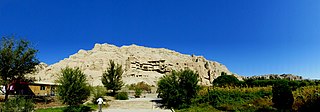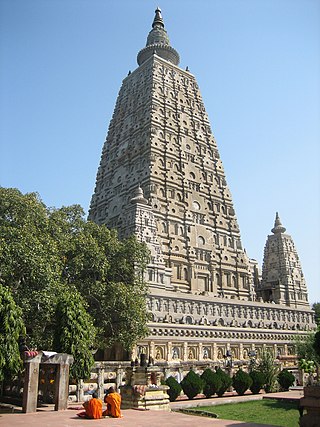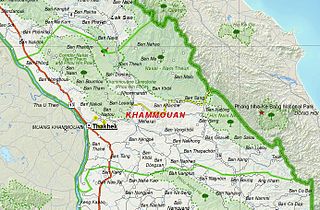Related Research Articles

The Ajanta Caves are 30 rock-cut Buddhist cave monuments dating from the second century BCE to about 480 CE in Aurangabad district of Maharashtra state in India. Ajanta Caves are a UNESCO World Heritage Site. Universally regarded as masterpieces of Buddhist religious art, the caves include paintings and rock-cut sculptures described as among the finest surviving examples of ancient Indian art, particularly expressive paintings that present emotions through gesture, pose and form.

Luang Prabang, historically known as Xieng Thong (ເຊືອງທອງ) and alternatively spelled Luang Phabang or Louangphabang, is the capital of Luang Prabang Province in north-central Laos. Its name, meaning “Royal Buddha Image,” derives from the Phra Bang, a revered statue symbolizing Lao sovereignty. Designated a UNESCO World Heritage Site in 1995, the city is recognized for blending traditional Lao architecture, European colonial buildings, and over 30 Buddhist temples. The protected area encompasses 33 of its 58 villages, where daily rituals like the morning alms-giving ceremony persist.

The Mogao Caves, also known as the Thousand Buddha Grottoes or Caves of the Thousand Buddhas, form a system of 500 temples 25 km (16 mi) southeast of the center of Dunhuang, an oasis located at a religious and cultural crossroads on the Silk Road, in Gansu province, China. The caves may also be known as the Dunhuang Caves; however, this term is also used as a collective term to include other Buddhist cave sites in and around the Dunhuang area, such as the Western Thousand Buddha Caves, Eastern Thousand Buddha Caves, Yulin Caves, and Five Temple Caves. The caves contain some of the finest examples of Buddhist art spanning a period of 1,000 years.

The Buddhas of Bamiyan were two possibly 6th-century monumental Buddhist statues in the Bamiyan Valley of Afghanistan. Located 130 kilometres (81 mi) to the northwest of Kabul, at an elevation of 2,500 metres (8,200 ft), carbon dating of the structural components of the Buddhas has determined that the smaller 38 m (125 ft) "Eastern Buddha" was built around 570 CE, and the larger 55 m (180 ft) "Western Buddha" was built around 618 CE, which would date both to the time when the Hephthalites ruled the region. As a UNESCO World Heritage Site of historical Afghan Buddhism, it was a holy site for Buddhists on the Silk Road. However, in March 2001, both statues were destroyed by the Taliban following an order given on February 26, 2001, by Taliban leader Mullah Muhammad Omar, to destroy all the statues in Afghanistan "so that no one can worship or respect them in the future". International and local opinion condemned the destruction of the Buddhas.

Vajrapāṇi is one of the earliest-appearing bodhisattvas in Mahayana Buddhism. He is the protector and guide of Gautama Buddha and rose to symbolize the Buddha's power.

The Kizil Caves are a set of Buddhist rock-cut caves located near Kizil Township in Baicheng County, Aksu Prefecture, Xinjiang, China. The site is located on the northern bank of the Muzat River 65 kilometres west of Kucha. This area was a commercial hub of the Silk Road. The caves have an important role in Central Asian art and in the Silk Road transmission of Buddhism, and are said to be the earliest major Buddhist cave complex in China, with development occurring between the 3rd and 8th centuries CE. The caves of Kizil are the earlier of their type in China, and their model was later adopted in the construction of Buddhist caves further east. Another name for the site has been Ming-oi (明屋), although this term is now mainly used for the site of Shorchuk to the east.

Vihāra generally refers to a Buddhist temple or Buddhist monastery for Buddhist renunciates, mostly in the Indian subcontinent. The concept is ancient and in early Pali texts, it meant any arrangement of space or facilities for dwellings. The term evolved into an architectural concept wherein it refers to living quarters for monks with an open shared space or courtyard, particularly in Buddhism. The term is also found in Jain monastic literature, usually referring to temporary refuge for wandering monks or nuns during the annual Indian monsoons. In modern Jainism, the monks continue to wander from town to town except during the rainy season (chaturmasya), and the term "vihara" refers to their wanderings.

Vientiane is the capital and largest city of Laos. Situated on the banks of the Mekong River at the Thai border, it comprises the five urban districts of Vientiane Prefecture and had a population of 840,000 as of the 2023 Census. Established as the capital of the Lan Xang Kingdom in 1563, Vientiane served as the administrative center during French rule and retains colonial-era architecture alongside Buddhist landmarks such as Pha That Luang, a national symbol of Buddhism, and Haw Phra Kaew, which once housed the Emerald Buddha until its 18th-century relocation to Thailand.

Tham Pha, also known as Buddha Cave, is a cave in Khammouane Province, Laos. The Karst limestone cave was only discovered in April 2004 by a local farmer who upon entering it found a treasure trove of 229 Buddha statues, estimated to be over 450 years old. It is believed that the Buddha statues were hidden to prevent them being looted by invading Haw peoples. The largest Buddha statue is seated at the main entrance. A stupa is located at the nearby Tham That cave.
The Tham Sang Triangle refer to a group of four caves in close proximity, located roughly 8 kilometres (5.0 mi) north of Vang Vieng, Laos, to the northwest of the village of Ban Pakpo. The four caves are Tham Sang, Tham Hoi, Tham Loup, and Tham Nam. The name "Tham Sang" refers to the stalactites within them which are said to resemble elephants, a characteristic in particular of the Tham Sang cave. The entrance has a grey boulder on the right side with a red flower bush beyond that. Tham Hoi is considered the most sacred to locals, with a larger Buddha head in the entrance, whilst Tham Loup is noted for its stalactites. Tham Nam, meaning "water cave", is located roughly 400 metres (1,300 ft) south of Tham Hoi.

Vientiane province is a province of Laos in the country's northwest. As of 2015 the province had a population of 419,090.

Houaphanh province is a province in eastern Laos. Its capital is Xam Neua.

Khammouane province (Khammouan) is a province in the center of Laos. Its capital lies at Thakhek.

Sainyabuli province is a province in northwest Laos. The capital of the province is the town of Saiyabuli. Saiyabuli is the only Lao province that is completely west of the Mekong River.

Vientiane Prefecture is a prefecture of Laos, in northwest Laos. The national capital, Vientiane, is in the prefecture. The prefecture was created in 1989, when it was split off from Vientiane province.

Luang Prabang is a province in northern Laos. Its capital of the same name, Luang Prabang, was the capital of the Lan Xang Kingdom during the 13th to 16th centuries. It is listed since 1995 by UNESCO as a World Heritage Site for unique architectural, religious and cultural heritage, a blend of the rural and urban developments over centuries, including the French colonial influences during the 19th and 20th centuries. The province has 12 districts.

Oudomxay is a province of Laos, located in the northwest of the country. Its capital is Muang Xai.

Champasak is a province in southwestern Laos, near the borders with Thailand and Cambodia. It is one of the three principalities that succeeded the Lao kingdom of Lan Xang. As of the 2015 census, it had a population of 694,023. The capital is Pakse, but the province takes its name from Champasak, the former capital of the Kingdom of Champasak.

Phnom Sorsia is a Buddhist hill complex in Kampot Province, southern Cambodia. It contains Buddhist cultural features approached by a staircase and a complex of karst caves. One cave Rung Damrey Saa has a stalagmite resembling the head of an elephant; another has a bat colony. The gateway to the caves is marked by a pagoda, approximately 1 kilometre (0.62 mi) from the main road.

The killing caves of Phnom Sampeau are a Khmer Rouge (KR) execution site on Phnom Sampeau, a hill 7 miles (11 km) southwest of Battambang in western Cambodia. KR killed their victims on top of the cave at the rim of a daylight shaft or ceiling hole and threw the corpses into the cave. Men and women were placed in separate caves and clothes in another. Phnom Sampeau has multiple caves that traditionally served as Buddhist temples. A large glass memorial in the cave next to the skulls and bones and a golden reclining Buddha mark the massacre. A memorial assembled from cyclone fencing and chicken wire contains human bones.
References
- 1 2 Burke, Andrew; Vaisutis, Justine (1 August 2007). Laos . Lonely Planet. p. 123. ISBN 978-1-74104-568-0 . Retrieved 21 July 2012.
- ↑ DK Eyewitness Travel Guide: Cambodia & Laos. Dorling Kindersley Limited. 1 June 2011. p. 172. ISBN 978-1-4053-4985-7 . Retrieved 21 July 2012.